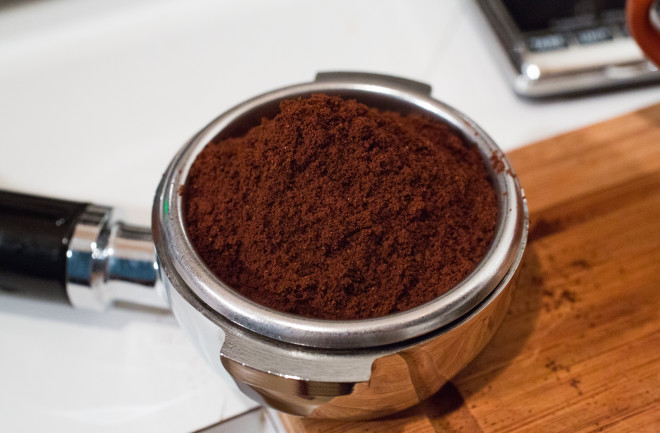Photo credit: Scott Schiller (schill/Flickr) Ever contemplated if the coffee grounds you’re about to toss away could be put to better use? Quite a number of scientists have, with proposed uses in fields ranging from bioenergy to food and pharmaceutical industries [1-3]. Some proposals involve recovering a chemical of interest from the coffee grounds, but a collaboration among researchers in Italy and Spain shows that the dregs, grit and all, can be just as useful to the scientific community. In this study, coffee grounds were treated with boiling hydrochloric acid, creating a black powder which exhibited high antioxidant potency. Analyses of this powder suggest that the hydrochloric acid helped remove components such as carbohydrates from the coffee grounds, leaving behind a product containing the coffee grounds’ polyphenol-rich compounds – in other words, plant chemicals with antioxidant capabilities. The resulting boiled coffee grounds were then applied in a number of experiments to examine their potential in the pharmaceutical, food, and polymer industries.
Coffee grounds were boiled in concentrated hydrochloric acid, then tested as a potential biomaterial for the pharmaceutical, food, and polymer industries. As a biomaterial in the pharmaceutical industry: Aging, and our increased susceptibility to cancer as we age, can be partially attributed to radical oxygen species (ROS). In this study, human liver cancer cell lines (HepG2) treated with the boiled coffee grounds were shown to be better protected against ROS, containing lower levels of ROS compared to cell lines tested with untreated spent coffee grounds. Furthermore, cell lines treated with the boiled coffee grounds were shown to better recover from oxidative stress caused by ROS. The chlorogenic acid found in the coffee grounds could be responsible for the oxidative protection [4], although further investigations into boiled coffee grounds as a potential antioxidant treatment are required. As a biomaterial in the food industry: Oils are susceptible to spoilage by lipid oxidation, with some studies deeming the lipid oxidation products to be toxic to living cells and promote fatty plaque buildup in the arteries [5]. When the boiled coffee grounds were added to samples of cod liver and soybean oil, the oils contained fewer lipid oxidation products than untreated samples. These results suggest that the boiled coffee grounds have promise as a food preservative for fat- and oil-based food products. As a biomaterial in the polymer industry: Polyethylene is commonly used in plastic bags, films, and some types of plastic bottles. When combined with boiled coffee grounds, a thin plastic film is created that is transparent and lightly coffee-colored. But how does this new material hold up against a regular plastic bag? Under various stability tests, the polyethylene-coffee grounds film blend was shown to better withstand deformation and breakages under increased heat and UV conditions, compared to regular polyethylene films. Spent coffee grounds could thus provide a simple way to make plastics that are more durable and biocompatible than current polyethylene plastics. Boiled coffee grounds as a biomaterial has notable industrial benefits. The starting material, used coffee grounds, is easily accessible, cheap, and environmentally friendly; the product shows high antioxidant properties and has good biocompatibility. While coffee grounds may still be a long way from commercial-scale use as a medical treatment, food preservative, or plastic bag, for now, your morning coffee leftovers can be easily recycled around your home and garden.
References cited
Vardon, D.R., Moser, B.R., Zheng, W., Witkin, K., Evangelista, R.L., Strathmann, T.J., Rajagopalan, K., Sharma, B.K., Complete utilization of spent coffee grounds to produce biodiesel, bio-oil, and biochar. ACS Sustainable Chemistry & Engineering, 2013; 1: 1286-1294.
Mussatto, S.I., Machado, E.M.S., Martins, S., Teixeira, J.a., Production, composition, and application of coffee and its industrial residues. Food and Bioprocess Technology, 2011; 4: 661-672.
Campos-Vega, R., Loarca-Piña, G., Vergara-Castañeda, H.A., Oomah, B.D. Spent coffee grounds: a revew on current research and future prospects. Trends in Food Science and Technology, 2015; 45: 24-36.
Granado-Serrano, A. B.; Martín, M. A.; Izquierdo-Pulido, M.; Goya, L.; Bravo, L.; Ramos, S. Molecular mechanisms of (−)-epicatechin and chlorogenic acid on the regulation of the apoptotic and survival/proliferation pathways in a human hepatoma cell line. Journal of Agricultural and Food Chemistry, 2007; 55: 2020−2027.
Kanner, J. Dietary advanced lipid oxidation endproducts are risk factors to human health. Molecular Nutrition and Food Research, 2007; 51: 1094−1101
Alice Phung once had her sights set on an English degree, but eventually switched over to chemistry and hasn't looked back since. Read more by Alice Phung
About the author:

